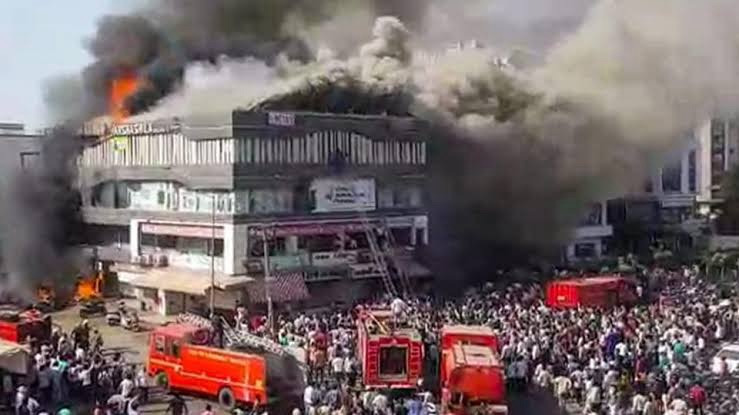Introduction
Surat, famously known as Diamond City, is one of the fastest-growing cities in India, renowned for its vibrant culture and economic prowess. On May 24, 2019, this bustling city was struck by a devastating fire at the Takshashila Arcade in the Sarthana area, leading to the tragic loss of 22 young lives. This incident not only highlighted the severe deficiencies in fire safety measures but also underscored the urgent need for public awareness and systemic change.
Description of Event
Takshashila Arcade was a four-story commercial building with coaching centers on the third and fourth floors. On that fateful day, around 3:30 pm, a fire erupted on the ground floor, reportedly due to an electrical short circuit in an air-conditioner. The fire quickly spread, engulfing the entire building and blocking the staircases, which forced the students to seek refuge on the terrace. Trapped with no means of escape, many students were compelled to jump from the top floor to save themselves from the flames and suffocating smoke.
The top floor, where the coaching center was located, was particularly vulnerable. It was a makeshift dome-like structure with plastic walls and roof, a ceiling only five feet high, and seats made from tyres. The presence of these combustible materials, along with a wooden staircase, significantly exacerbated the situation.
Impact and Loss
According to eyewitnesses, between 50 and 70 students were inside the building when the fire started. The tragedy claimed the lives of 22 individuals, including 18 girls aged 16 to 19 and four teenage boys. Five of these victims died from injuries sustained while jumping from the top floor, while the others succumbed to the blaze. Additionally, 16 students and a child aged 3 to 4 years suffered serious injuries and required hospitalization. The survivors faced not only physical injuries but also severe emotional trauma.
Response and Rehabilitation
The fire response involved 19 fire tenders and two hydraulic platforms, It took approximately an hour to control the fire, with local residents assisting in rescue operations.
In the aftermath, the Chief Minister ordered a probe into the incident and announced financial aid of Rs. 4 lakhs for the families of the deceased. An FIR was filed against three individuals, including the builders of the complex and the owner of the coaching center.
Eyewitness Accounts
Survivors and witnesses recounted their harrowing experiences:
- Urmila Patel, 15: “We were on the fourth and top floor. Suddenly, there was smoke all around. We found it extremely difficult to breathe. We shouted for help…I called out for my mother and rushed toward the only staircase. But stairs were also engulfed in fire…Like all others, I and my other friend rushed back to the room…we had no option but to jump. I saw others jumping off and followed them.”
- Happy Panchali, 15: “What I experienced was hell. I do not know for how long I was in the building and what made me jump off. All I remember was everyone was crying for help. After jumping off, I thought I was dead.”
Real Cause of the Fire: A Hidden Truth
As a citizen of Surat and a firsthand observer, it is crucial to address the discrepancies in the official account of the fire’s origin. Contrary to the reported cause of an electrical short circuit in an air-conditioner, local knowledge indicates that the fire began from a transformer located near the staircase. This transformer was illegally placed, contravening safety regulations that prohibit such installations in that area. Alarmingly, the transformer was removed the same night after the fire, and this critical detail was omitted from the government report.
The suppression of this truth from public records, such as in the book “FIRES IN INDIA: LEARNING LESSONS FOR URBAN SAFETY” by the National Institute of Disaster Management (NIDM), undermines public trust and fails to educate future generations accurately. It is imperative that the real causes of such disasters are transparently documented to prevent recurrence and to truly learn from past mistakes.
Conclusion
The Takshashila fire tragedy is a stark reminder of the urgent need for stringent fire safety regulations and public awareness. The loss of 22 young lives is a somber call to action for better preparedness, stricter enforcement of safety standards, and honest reporting of facts. By learning from this incident and advocating for comprehensive safety measures, we can honor the memory of those lost and work towards a safer future.
As we move forward with the “HowToSurvive” initiative, let us commit to raising awareness, educating the public, and ensuring that the truth is not obscured. Only through collective effort and accountability can we hope to build a resilient and prepared society.
————
This blog post provides a comprehensive account of the Takshashila fire tragedy, emphasizing the importance of transparency and the lessons we must learn to improve safety and preparedness.


